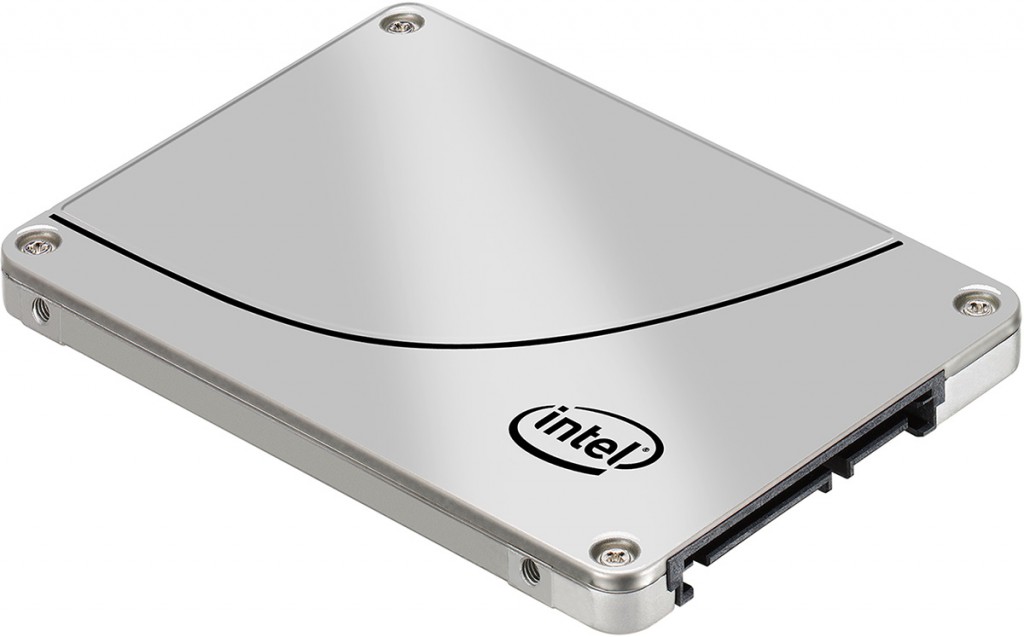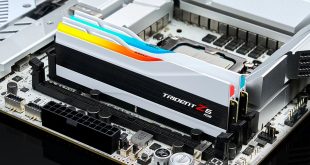At present solid-state drives with extreme capacities are very expensive and even the best of them cannot match high-capacity hard disk drives for nearline storage applications. However, thanks to the evolution of NAND flash memory in general, and 3D vertical NAND (3D V-NAND) in particular, the situation may change soon and SSDs with 10TB or higher capacities will become reality.
Intel Corp. revealed at its Investor Meeting 2014 event this week that in the second half of 2015 its joint venture with Micron Technology – Intel Micron Flash Technologies (IMFT) – will start mass production of 3D vertical NAND flash memory chips with up to 256Gb (multi-level cell, 2-bit-per cell) or 384Gb (triple-level cell, 3-bit-per cell) capacity. 3D V-NAND flash memory chips will feature 32-layer vertically stacked cell arrays that are “interconnected” using four billion through silicon vias (TSVs).
The upcoming 3D NAND chips from Intel and Micron will enable solid-state drives with capacities simply not possible today. According to Rob Crooke, senior vice president and general manager of Intel's non-volatile memory group, the 3D NAND will enable 10TB and larger solid-state storage solutions in the next two years.
In a bid to build 4TB Optimus Max solid-state drive earlier this year, SanDisk had to use 64 extremely expensive 64GB (512Gb) eMLC NAND flash memory packages (which integrate four 128Gb eMLC memory chips into one package) that rely on planar NAND flash and are made using thin process technologies. By contrast, Intel’s 256Gb MLC 3D NAND flash memory chip which can hold up to 32GB of data (384Gb/48GB TLC NAND flash) will be made using a mature (i.e., thicker) process technology (Intel does not disclose which one) and will have a “breakthrough” cost. As a result, multi-terabyte solid-state drives will not only become reality, but will not cost several thousands of pounds per unit.
Mr. Crook used a prototype solid-state drive based on the 32-layer 256Gb MLC NAND flash memory to run his presentation at the Investor Meeting 2014, which means that the technology is viable and products on its base are already functional.
At present Samsung Electronics produces 128Gb 24-layer and 32-layer 3D V-NAND MLC NAND memory chips using 42nm process technology. According to Chipworks, “visible” capacity of the 128Gb MLC 3D V-NAND chips is 86Gb, which means that Samsung remains pretty cautious about its multi-layer MLC NAND memory.
Intel’s 3D NAND memory project seems to be far more ambitious than Samsung’s: it will start at 32 layers and 256Gb capacity, which means that Intel’s chips will be more cost-efficient than those from its rival.
While Intel’s upcoming 3D NAND chips could feature the cheapest cost-per-bit in the industry, its effect on the market of NAND flash-based storage may be limited. IMFT can produce around 70 thousand of 300mm wafers per month, which includes different types of memory, based on data from a ChinaFlashMarket.com report. While Intel and Micron could manufacture their 3D NAND memory at IMFS (80 thousand of 300mm wafers per month) or MTV (40 thousand of 300mm wafers per month) fabs, they will hardly be able to produce volumes comparable to those of Samsung’s. The South Korea-based conglomerate produces 3D V-NAND at its China Xi’an fab that is dedicated to this type of memory and which can process 100 thousand 300mm wafers per month. In addition, Samsung can make 3D V-NAND at other facilities, which total production capacity exceeds 400 thousand 300mm wafers per month.
Although Intel’s 3D NAND may not necessarily revolutionize the market of NAND flash storage in general, it still represents a great opportunity for the company to boost its revenue and SSD market share. Intel NAND and SSD revenue in 2014 is expected to be around $2 billion, thanks to innovations like 256Gb 3D NAND, it will grow further in the coming years.
Discuss on our Facebook page, HERE.
KitGuru Says: Solid-state drives of decent capacities are already pretty affordable, at least for the PC enthusiast world. Thanks to Intel’s 256Gb 3D NAND flash chips, the cost of SSDs will drop even more, which will mean that even affordable notebooks could replace hard disk drives with SSDs. Still, there is a new era of ultra-high-definition video and games incoming. To store massive amounts of UHD data, we will definitely need not only high-capacity SSDs, but also high-capacity HDDs.
 KitGuru KitGuru.net – Tech News | Hardware News | Hardware Reviews | IOS | Mobile | Gaming | Graphics Cards
KitGuru KitGuru.net – Tech News | Hardware News | Hardware Reviews | IOS | Mobile | Gaming | Graphics Cards





So, should i buy intel 730 ssd right now? or should i wait until my next build
let me know when 10Tb ssd’s will cost less than £50, thx.
there is always something to wait for. 2nd half of 2015 is not exactly around the corner, and the initial prices will be bumped up anyway. Get yourself some small capacity now, for selected apps and OS.
Please don’t post here anymore.
Don’t care.
Go away, Chav.
Retard.
Oh boy 10TB….that will more then likely cost about $1500 would my best guess. Seriously, it’s nice to know that that kind of thing is available, but that price scares off a lot of people.
This is how the market works. An epic product comes out with high prices, and enthusiasts buy the product at a high price. Once the enthusiasts buy it, the companies eventually find ways to make it cheaper. Its a vicious cycle. You might think the enthusiasts are getting screwed over, but they are aware of the cycle and choose to participate anyways to stay on the bleeding edge of tech.
bought intel 730 480gb ssd for $199 and yeah,… this is fast enough. Gonna get some more HDDs for storage
Your nickname from school.
Watch your language, you fucking twat.
Yay! Finally SSDs will phase out HDDs! Even if SSDs technology is already mature, but still going as far as to use helium in HDDs to surpass physical/mechanical limitations is getting really ridiculous. SDSs FTW buahahhaha!
What is wrong with 10TB? 10Tb is not much better than 1TB.
SSD not for below-poverty-line basement dwellers.
Imagine having a good dinner, and then finding a turd in your dessert – that’s your comment. And that’s you.
Cheapo poor boy Michal. Parents didn’t even have money to add the “e” to his first name LOL!
4 tb ssd at 200-300 pounds would have me sold and replaceing my mechs